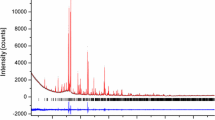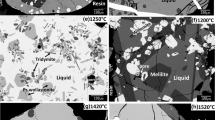Abstract
To further our knowledge of the effects of volatile components on phase relationships in aluminosilicate systems, we determined the vapor saturated solidi of albite, anorthite, and sanidine in the presence of CO2 vapor. The depression of the temperature of the solidus of albite by CO2 decreases from ∼30° C at 10 kbar, to ∼10° C at 20 kbar, to about 0 at 25 kbar, suggesting that the solubility of CO2 in NaAlSi3O8 liquid in equilibrium with solid albite decreases with increasing pressure and temperature. In contrast, CO2 lowers the temperature of the solidus of anorthite by ∼30° C at 14 kbar, and by ∼70dg C at 25 kbar. This contrasting behavior of albite and anorthite is also reflected in the behavior of melting in the absence of volatile components. Whereas albite melts congruently to a liquid of NaAl-Si3O8 composition to pressures of ∼35 kbar, anorthite melts congruently to only about 10 kbar and, at higher pressures, incongruently to corundum plus a liquid that is enriched in SiO2 and CaO and depleted in Al2O3 relative to CaAl2Si2O8.
The tendency toward incongruent melting with increasing pressure in albite and anorthite produces an increase in the activity of SiO2 component in the liquid (\(a_{SiO_2 }^l \)). We predict that this increases the ratio of molecular CO2/CO 2−3 in these liquids, but the experimental results from other workers are mutually contradictory. Because of the positive dP/dT of the albite solidus and the negative dP/dT of the anorthite solidus, we propose that a negative temperature derivative of the solubility of molecular CO2 in plagioclase liquids may partly explain the decrease in solubility of carbon with increasing pressure in near-solidus NaAlSi3O8 liquids, which is in contrast to that in CaAl2Si2O8 liquid. Also, reaction of CO2 with NaAlSi3O8 liquid to form CO 2−3 that is complexed with Na+ must be accompanied by a change in Al3+ from network-former to network-modifier, as Na+ is no longer abailable to charge-balance Al3+ in a network-forming role. However, when anorthite melts incongruently to corundum plus a CaO-rich liquid, the complexing of CO 2−3 with the excess Ca2+ in the liquid does not require a change in the structural role of aluminum, and it may be more energetically favorable.
The depression of the temperature of the solidus of sanidine resulting from the addition of CO2 increases from ∼50° C at 5 kbar to ∼170° C at 15 kbar. In marked contrast to the plagioclase feldspars, sanidine melts incongruently to leucite plus a SiO2-rich liquid up to the singular point at ∼15 kbar. Above this pressure, sanidine melts congruently, resulting in a decrease in the \(a_{SiO_2 }^l \) with increasing pressure in the interval up to ∼15 kbar. Above this pressure, the congruent melting of sanidine results in a lower and nearly constant \(a_{SiO_2 }^l \) relative to those of albite and anorthite, and CO2 produces a nearly constant freezing-point depression of about 170° C. Because of the low \(a_{SiO_2 }^l \) at pressures above the singular point, we infer that most of the carbon dissolves as CO 2−3 , resulting in a low CO2/ CO 2−3 , but a high total carbon content.
The principles derived from the studies of phase equilibria in these chemically simple systems provide some information on the structural and thermal properties of magmas. We propose that the \(a_{SiO_2 }^l \) is an important parameter in controlling the speciation of carbon in these feldspathic liquids, but it certainly is not the only factor, and it may be relatively less significant in more complex compositions. In addition, our phase-equilibria approach does not provide direct thermal and structural information as do calorimetry and spectroscopy, but the latter have been used primarily on glasses (quenched liquids) and cannot be used in situ to derive direct information on liquids at elevated pressures, as can our method. Hopefully, the results of all of these approaches can be integrated to yield useful results.
Similar content being viewed by others
References
Bell PM, Roseboom EH Jr (1969) Melting relationships of Jadeite and albite to 45 kbar with comments on melting diagrams of binary systems at high pressures. Mineral Soc Am Spec Pap 2:151–161
Boettcher AL (1970) The system CaO-Al2O3-SiO2-H2O at high pressures and temperatures. J Petrol 11:337–379
Boettcher AL (1984) The system SiO2-H2O-CO2: melting, solubility mechanisms of carbon, and liquid structure to high pressures. Am Mineral 69:823–833
Boettcher AL, Windom KE, Bohlen SR, Luth RW (1981) Low friction, anhydrous, low- to hightemperature furnace sample assembly for piston-cylinder apparatus. Rev Sci Instrum 52:1903–1904
Boettcher AL, Burnham CW, Windom KE, Bohlen SR (1982) Liquids, glasses, and the melting of silicates to high pressures. J Geol 90:127–138
Boettcher A, Guo Q, Bohlen S, Hanson B (1984) Melting in feldspar-bearing systems to high pressures and the structure of aluminosilicate liquids. Geology 12:202–204
Bohlen SR, Boettcher AL, Wall VJ (1982) The system albite-H2O-CO2: a model for melting and activities of water at high pressures. Am Mineral 67:451–462
Brey G (1976) CO2 solubility and solubility mechanisms in silicate melts at high pressures. Contrib Mineral Petrol 57:215–221
Dickinson JE Jr (1986) Liquidus phase equilibria and melt structure. In: Scarfe CM (ed) Short course in silicate melts. Mineral Assoc Can, pp 154–179
Eitel W, Weyl W (1932) Residuals in the melting of commercial glasses. J Am Ceram Soc 15:159–166
Fine G, Stolper E (1985) The speciation of carbon dioxide in sodium aluminosilicate glasses. Contrib Mineral Petrol 91:105–121
Goldsmith JR (1980) The melting and breakdown reactions of anorthite at high pressures and temperatures. Am Mineral 65:272–284
Hamilton DL, Chesworth W, Kennedy G, Fyfe C (1986) The absence of 6-fold coordinated Al in Jadeite melt near the Jadeite liquidus. Geochim Cosmochim Acta 50:123–124
Holloway JR, Mysen BO, Eggler DH (1976) The solubility of CO2 in liquids on the join CaO-MgO-SiO2-CO2. Carnegie Inst Washington Yearb 75:626–630
Luth RW, Boettcher AL (1986) Hydrogen and the melting of silicates. Am Mineral 71:264–276
Luth WC, Ingamells CO (1965) Gel preparation of starting materials for hydrothermal experimentation. Am Mineral 50:255–258
Mysen BO (1976) The role of volatiles in silicate melts: Solubility of carbon dioxide and water in feldspar, pyroxene, and feld-spathoid melts to 30 kb and 1625° C. Am J Sci 276:969–996
Mysen BO, Virgo D (1980) The solubility behavior of CO2 in melts on the join NaAlSi3O8-CaAl2Si2O8-CO2 at high pressures and temperatures: a Raman spectroscopic study. Am Mineral 65:1166–1175
Mysen BO, Eggler DH, Seitz MG, Holloway JR (1976) Carbon dioxide in silicate melts and crystals. Part I. Solubility measurements. Am J Sci 276:455–476
Mysen BO, Virgo D, Seifert FA (1982) The structure of silicate melts: implications for chemical and physical properties of natural magmas. Rev Geophys Space Phys 20:353–382
Ohtani E, Taulelle F, Angell CA (1985) Al3+ coordination changes in liquid aluminosilicates under pressure. Nature 314:78–81
Ringwood AE, Reid AF, Wadsley AD (1967) High pressure KAl-Si3O8, an aluminosilicate with 6-fold coordination. Acta Crystal 23:1093–1095
Spera FJ, Bergman SC (1980) Carbon dioxide in igneous petrogenesis. I. Aspects of the dissolution of CO2 in silicate liquids. Contrib Mineral Petrol 74:55–66
Author information
Authors and Affiliations
Additional information
Institute of Geophysics and Planetary Physics, Contribution No. 2744
Rights and permissions
About this article
Cite this article
Boettcher, A., Luth, R.W. & White, B.S. Carbon in silicate liquids: the systems NaAlSi3O8-CO2, CaAl2Si2O8-CO2, and KAlSi3O8-CO2 . Contr. Mineral. and Petrol. 97, 297–304 (1987). https://doi.org/10.1007/BF00371993
Received:
Accepted:
Issue Date:
DOI: https://doi.org/10.1007/BF00371993




